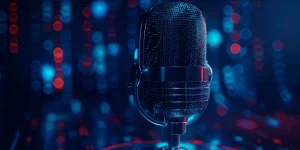https://open.spotify.com/episode/1SLkFh5pQ3A0Z660amik8u
Hello everyone and welcome to a fresh new episode of the Cognixia podcast. Every week, we come together to discuss something new from the world of emerging digital technologies and strive to inspire our listeners to learn something new and take the next big leap in their careers by ramping up their skills and knowledge. If you have been listening to us for a bit, welcome back, it is great to have you here. If you are a new listener, welcome, we are super happy to have you tune in today and we hope you will keep coming back for more.
In today’s episode, we talk about something that has been quite the talk of the town in the past. It has often left people confused, some people could have lost money in it, and some might have even made a small fortune in it. Today, we talk about NFTs. But before we dig deeper, we would like to tell you a little story from not so long ago.
About two years back, an artist named Beeple sold an NFT-based artwork for a whopping $69 million. In 2021, $69 million was equivalent to an unimaginable INR 5.2 billion. That was two years ago, and the world has gone around twice since. Since then, NFTs have shaken up the world of art, tech, and so many other subcultures. Interestingly, the journey has been quite a rollercoaster. Artists and collectors have built fortunes on the back of NFTs, a horde of brands have plunged into the space, marketing gimmicks galore, the metaverse has risen and gotten somewhat lost in the corridors of tech fads but keeps showing up here and there once in a while, and the space has become so happening. However, in recent times, NFTs have lost their shine a bit. Their momentum has dropped, the sales of NFTs have cratered considerably and the crypto market has seen an unignorable loss of value. Will the communities that got created during the early days of the NFTs still be maintained? Will those crazy growth days come back or was it just a fad that has now fizzled out? One thing we can say for sure is that the situation is somewhat complicated and things are not as easy as they might seem. But we don’t intend to scare you off, so let us begin simply by first trying to understand what are NFTs.
Some people called “N. F. T.”, some call it “nefts”. NFT stands for non-fungible token. Non-fungible is an attribute of the token implying that the token is unique and cannot be replaced by something else. To give you an example, a bitcoin is a fungible token, you can trade one bitcoin for another, and it will still be the same thing, right? However, NFTs are one-of-a-kind. If you traded an NFT for another NFT, you will have a different NFT in your possession and not the same one you originally had because each NFT is different, which means, it is non-fungible. So, to put it in one line, an NFT is an irreplaceable, unique token. Now, how do the NFTs function?
If you look at it from a very high level, non-fungible tokens are a part of the Ethereum blockchain. If you didn’t already know, NFTs are a part of the blockchain, specifically the Ethereum blockchain. For the uninitiated, Ethereum is like a cryptocurrency, like say bitcoin or dogecoin. However, the tracking of who is holding and trading what NFTs is kept by blockchain.
NFTs can be anything digital, could b drawings, could be music, could even your brain downloaded and turned into AI, like that scientist from Dan Brown’s book Origin, remember? However, the most common application of NFTs has been in the buying and selling of digital art. You know how buying a Picasso or a Van Gogh is a classy, expensive affair? The NFTs are doing something similar for digital art. It is the next evolution in the fine art collecting space, just with digital art instead of real, physical one. We are not saying that digital art is not real art, it most definitely is, what we are saying is the art pieces exist in the digital space, not the real, physical space. Not just art, even your tweets could be sold for NFTs. For instance, the founder of Twitter – Jack Dorsey put up one of his tweets for auction with NFTs and the last known offer to purchase the tweet stood at $2.5 million.

At this point, we might as well give you a quick primer on what is blockchain, just to help understand everything a bit better. Now, blockchains are a very complex subject to explain in short, but we are going to try. So, blockchain is a way to store data without requiring to trust any one person or entity, or company to maintain or be accountable for the security and accuracy of the data being stored. There could be exceptions and complex situations where this may not be the full situation, but whenever somebody says ‘blockchain’, they usually mean a technology that is based on this principle.
A bitcoin is an on-chain component on the blockchain – so the person owing the bitcoin would control the private key to a specific address on the blockchain. This could be a direct association or it could be via a cryptocurrency wallet. To sell the bitcoin, the owner transfers the key to another address, then they no longer own that key.
Similarly, NFT has an on-chain component on the blockchain too. But, they also have an off-chain component. The on-chain component of NFT is a software-based smart contract that can be initiated by anybody who owns the key to that address. The asset controlled by the NFT could exist on-chain or off-chain. When it exists off-chain, there is an invisible legal connection that connects the on-chain and off-chain components. In the legal world, this connection is called ‘tethering’.
If we look at the things people have been buying using NFTs, we are sure they believe that NFTs will be the future of collecting. Someone has paid $390,000 for a 50-second video by Grimes. Someone has also paid $6.6 million for a video by Beeple. Once you purchase a digital artwork using NFTs, you can copy, paste, and use the artwork as many times as you like or a single time, depending on the conditions of purchase and the configuration of the file you have received attached to the NFT. Then, you might wonder, what is the point of spending such humongous amounts to purchase any artwork if it can be copied and shared as many times as the owner pleases? Well, NFT gives you something that cannot be copied and shared thus – it gives you ownership of the artwork. The artist may or may not retain the copyright for the artwork and they may or may not control the rights to reproduction for that artwork, the same as it happens with the physical works of art. To give you a better perspective of this, imagine you see a print of one of Claude Monet’s fantastic works – the Water Lily Pond in a shop. You can buy the print anytime. But only one person would own the original Water Lily Pond by Claude Monet. Everybody else would just have copies or duplicates or fakes. There can be only one original. And that is exactly what you pay for when you acquire digital art with NFTs.
NFTs sure make copyright a complicated subject, don’t they? Surveys have found that many NFT projects did not take the necessary steps to execute a standard, formal copyright license for the work that was connected to the NFTs.
However, if you have been keeping up with the news in this space, it is believed that NFTs are done and dusted now. The sales of NFTs have fallen to steep lows since they peaked back when they were all the rage. NFTs had a big spike and then it kept nosediving uncontrollably. Will NFTs make a comeback? Well, only time can answer that question but we do know there are many believers in the power of NFTs and they are definitely betting that NFTs will be back soon.
Does that gives a small primer on NFTs – what they are, how they function, should you buy them or not? We surely hope we helped clear up some things and inspired you to dig deeper before considering buying NFTs, instead of falling for the hype or hearsay straight away. Inspire to learn something new, now that’s what we strive for!
With that, we come to the end of this week’s episode of the Cognixia podcast. We hope you enjoyed listening to us and that we helped you learn something new today. To continue your learning journey, we strongly recommend checking out our website – www.cognixia.com to discover the best-in-class live-online instructor-led courses in the latest emerging digital technologies. Sign up for one and future-proof your career!
Until next week then!
Happy Learning!




